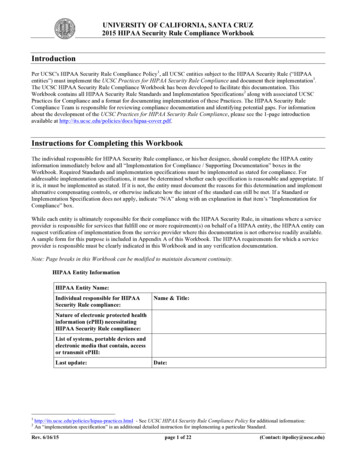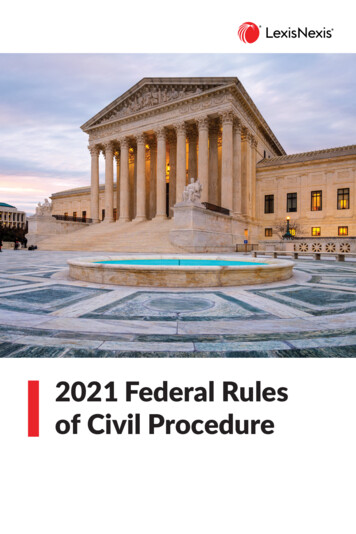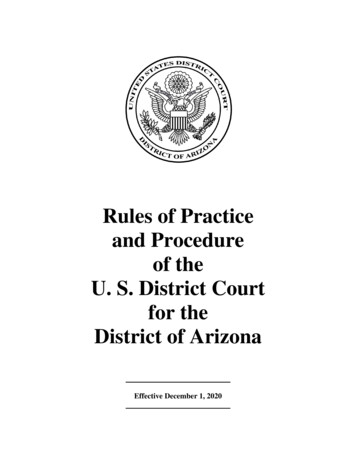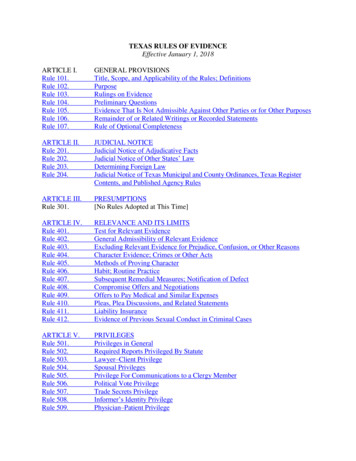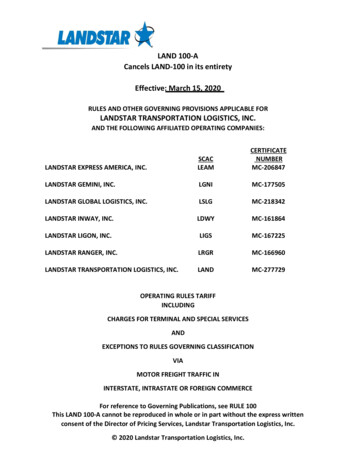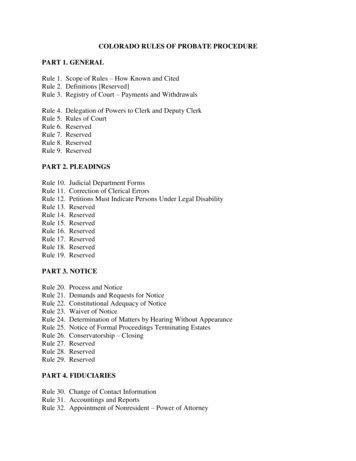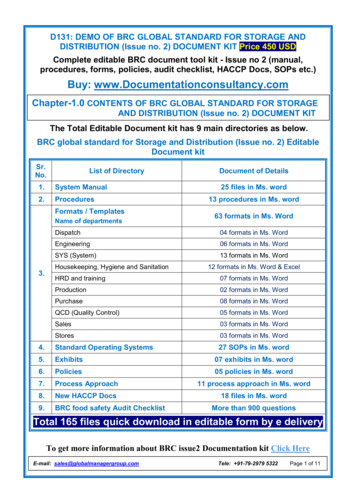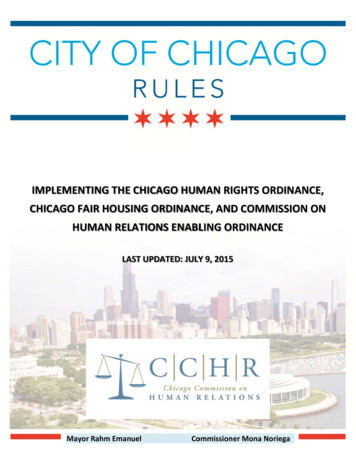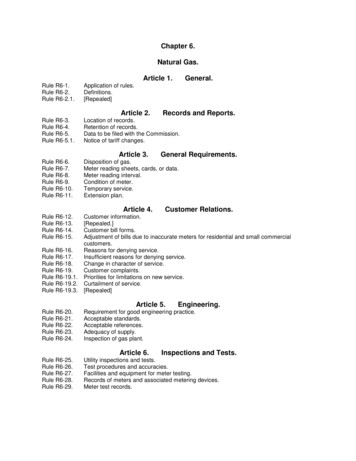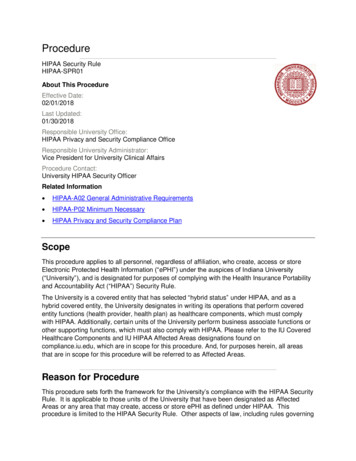
Transcription
ProcedureHIPAA Security RuleHIPAA-SPR01About This ProcedureEffective Date:02/01/2018Last Updated:01/30/2018Responsible University Office:HIPAA Privacy and Security Compliance OfficeResponsible University Administrator:Vice President for University Clinical AffairsProcedure Contact:University HIPAA Security OfficerRelated Information HIPAA-A02 General Administrative Requirements HIPAA-P02 Minimum Necessary HIPAA Privacy and Security Compliance PlanScopeThis procedure applies to all personnel, regardless of affiliation, who create, access or storeElectronic Protected Health Information (“ePHI”) under the auspices of Indiana University(“University”), and is designated for purposes of complying with the Health Insurance Portabilityand Accountability Act (“HIPAA”) Security Rule.The University is a covered entity that has selected “hybrid status” under HIPAA, and as ahybrid covered entity, the University designates in writing its operations that perform coveredentity functions (health provider, health plan) as healthcare components, which must complywith HIPAA. Additionally, certain units of the University perform business associate functions orother supporting functions, which must also comply with HIPAA. Please refer to the IU CoveredHealthcare Components and IU HIPAA Affected Areas designations found oncompliance.iu.edu, which are in scope for this procedure. And, for purposes herein, all areasthat are in scope for this procedure will be referred to as Affected Areas.Reason for ProcedureThis procedure sets forth the framework for the University’s compliance with the HIPAA SecurityRule. It is applicable to those units of the University that have been designated as AffectedAreas or any area that may create, access or store ePHI as defined under HIPAA. Thisprocedure is limited to the HIPAA Security Rule. Other aspects of law, including rules governing
privacy and human subject research, are addressed in other University policies. See theUniversity’s IRB website for policies governing human subject research, and the University’sPolicies, Procedures and Handbooks web site for policies concerning privacy and computersecurity.ePHI includes any electronic data relating to the past, present or future physical or mentalhealth, health care, treatment, or payment for health care. ePHI includes information that canidentify an individual, such as name, social security number, address, date of birth, medicalhistory or medical record number, and includes such information transmitted or maintained inelectronic format, but excluding certain employment and student records.DefinitionsSee Glossary of HIPAA Related Terms for a complete list of terms.Procedure StatementAs a hybrid entity, the HIPAA Security Rule requires Affected Areas within the University to: put into place appropriate administrative, technical, and physical safeguards to ensurethe integrity, confidentiality and availability of all ePHI that is created, received,maintained or transmitted by the University.protect against any reasonably anticipated threats or hazards to the security or integrityof ePHI.protect against reasonably anticipated uses or disclosures of ePHI that are not permittedor required under 45 CFR part 164, subpart E.ensure compliance with the HIPAA Security Rule by the University workforce.SECURITY MEASURESThe following security measures address the standards and specifications of the HIPAASecurity Rule and reference IU Policy where applicable. Each Affected Area must implementthese measures and review and modify their security practices as needed to sustain thereasonable and appropriate protection of the confidentiality, integrity, and availability of ePHI.Implementation of security measures to address HIPAA requirements should be reasonable andappropriate, taking into account: The size, complexity, and capabilities of the Affected Area;The Affected Area’s technical infrastructure, hardware, and software securitycapabilities;The costs of security measures; andThe probability and criticality of potential risk to ePHI.Documentation requirementsDocumentation. To address HIPAA Section 164.316, all Affected Areas will maintain electronicdocumentation pertaining to any action, activity, assessment, policy, or procedure related to thisthe implementation of this procedure and the HIPAA Security Rule. This documentation must be
available to workforce members responsible for implementing policies and procedures andretained in a secure location for 6 years from the date of creation or the date it was last in effect,whichever is later. Documentation should include proof that the policies are being followed andprocedures performed, and those artifacts should be available for review in the event of anaudit. Examples include but are not limited to: Policies & Procedures, including prior versions Risk Analyses (includes ePHI system inventory) Risk Management Plans Implementation results of Risk Management Plans Exceptions to Policies Rationale in choosing an Alternate Control Documentation related to access control Security Incident investigationsAdministrative SafeguardsA. Security Management – Section 164.308(a)(1)1. Risk Assessment. To address HIPAA Section 164.308(a)(1)(ii)(A), Risk Analysis, allAffected Areas will assign key workforce members to participate in and support a yearlyrisk analysis, which may include, but is not limited to their provision of an inventory ofworkflows, systems, people, processes, technologies, and safeguards related to ePHI.This Risk Analysis will provide an accurate and thorough assessment of the potentialrisks and vulnerabilities to the confidentiality, integrity, and availability of ePHI managedby the Affected Area. This risk analysis will be managed by the University HIPAAPrivacy and Security Compliance Office and will be presented to the area’smanagement, who will provide support for the risk management plan set forthbelow. Additional risk analysis activities will be performed as needed to support majorchanges such as the introduction of new systems or new HIPAA Affected Areas.2. Risk Management Program. To address HIPAA Section 164.308(a)(1)(ii)(B). RiskManagement, the University HIPAA Privacy and Security Compliance Office will developa Risk Management Plan in response to the threats and vulnerabilities identified duringthe risk analysis. Additionally, all Affected Areas will assign resources to support RiskManagement Plan implementation activities to reduce ePHI related risks andvulnerabilities to an appropriate level, including:2.1Implementation of security measures appropriate in response to threats andvulnerabilities identified during the risk analysis and on an on-going basis asidentified.2.2Creation of documented evidence to support that security measuresimplemented to address threats and vulnerabilities identified during risk analysishave sufficiently mitigated or remediated identified risks to an area managementacceptable level and comply with general requirements under HIPAA Section164.306(a).
3. Sanction Policy. To address HIPAA Section 164.308(a)(1)(ii)(C), Sanction Policy, allAffected Areas will adhere to the applicable University sanctions policy, refer to IUHIPAA-G01 Sanctions as a guidance.4. Information Systems Activity Review. To address HIPAA Section 164.308(a)(1)(ii)(D),Information System Activity Review, all Affected Areas will assign key workforcemembers to regularly review information system activity records—including audit logs,access reports, and security incident tracking reports—to ensure that implementedsecurity controls are effective and that ePHI has not been potentially compromised.Measures that each Affected Area will address include:4.1Developing a procedure to review event logging configurations on computersystems managing ePHI to ensure a configuration consistent with IU Policy IT-12and the Audit Controls section of this procedure to address HIPAA Section164.312(b).4.2Developing a procedure to review and approve the capabilities of informationsystem activity logs with area management.4.3Developing a procedure for the regular and timely review of audit logs, accessexception reports, and security incident reports.B. Assign Security Responsibilities – Section 164.308(a)(2)1. Security Officials. To address HIPAA Section 164.308(a)(2), Assigned SecurityResponsibility, the University has named a University HIPAA Security Officer. Inaddition, each Affected Area will name at least one HIPAA Security Liaison responsiblefor working with the University HIPAA Security Officer to implement this procedure andsafeguards required to protect the confidentiality, integrity, and availability of ePHI.When appropriate, the HIPAA Security Liaison may also serve as the HIPAA PrivacyLiaison.2. Document Security Responsibility. To address HIPAA Section 164.308(a)(2),Documenting Security Responsibility, each Affected Area will document the name of theHIPAA Security Liaison, the date they were named a HIPAA Security Liaison, and thescope of their assigned duties.C. Workforce Security – Section 164.308(a)(3)1. Workforce Security. To address HIPAA Section 164.308(a)(3), Workforce Security, allAffected Areas will establish procedures that ensure workforce members have minimumnecessary access to ePHI on the information systems used and supported by theirworkforce. In addition, all Affected Areas will implement procedures for terminatingaccess to ePHI when the employment of a workforce member ends or the jobresponsibilities of the workforce member no longer warrants access to ePHI. Measuresthat each Affected Area will address include:1.1Establishing a procedure that implements IU’s Data Governance principle ofassigning Data Managers to receive, evaluate, and authorize or deny requestsfor access to ePHI on information systems supported by an area.1.2Performing appropriate background checks before any person is granted accessto ePHI or information systems that store ePHI.1.3Establishing a procedure for Data Managers to regularly review and revalidateworkforce members access to ePHI to ensure that access to ePHI is appropriate.
1.4Establishing a procedure to remove/disable/modify access to ePHI, collectaccess control devices, and conduct exit interviews regarding privacy andsecurity of ePHI when the employment of a workforce member ends or the jobresponsibilities no longer require access to ePHI.D. Information Access Management – Section 164.308(a)(4)1. Information access Management. To address HIPAA Section 164.308(a)(4),Information Access Management, all Affected Areas will establish procedures thatensure all access to ePHI is appropriately authorized. Measures that each Affected Areawill address include:1.1 Establishing a procedure to make use of a searchable system to create andtrack requests and changes to access.1.2 Establishing a procedure to define and communicate appropriate workforceaccess consistent with the University’s Minimum Necessary Policy HIPAA-P02to the appropriate Data Manager and individuals assigned to implement accesschanges.1.3 Establishing a procedure to regularly perform a technical evaluation of accesscontrols on information systems storing ePHI to ensure the implementation ofthe appropriate access.1.4 Establishing a procedure to isolate clearinghouse functions and to protect ePHIfrom unauthorized access.E. Security Awareness and Training – Section 164.308(a)(5)1. Security Reminders. To address HIPAA Section 164.308(a)(5)(ii)(A), SecurityReminders, Affected Areas will ensure a procedure is in place to receive anddisseminate periodic security updates. Affected Areas will acquire these periodicsecurity updates from the HIPAA Privacy and Security Compliance Office and fromsources required by IU Policy IT-12. In addition, Affected Areas will establish aprocedure to ensure all members of their workforce complete HIPAA Privacy andSecurity training as described in IU Policy HIPAA-A02.2. Protection from Malicious Software. To address HIPAA Section 164.308(a)(5)(ii)(B),Protection from Malicious Software, Affected Areas will ensure a procedure is in place totrain workforce members of the risks associated malicious software, how malicioussoftware is detected, and to report detections of malicious software as a computersecurity incident under IU Policy ISPP-26.3. Log-in Monitoring. To address HIPAA Section 164.308(a)(5)(ii)(C), Log-in Monitoring,Affected Areas will ensure a procedure is in place to train their workforce on how to useIU provided monitoring solutions to review personal account activity and to receive log-inalerts. Workforce members must be trained to look for inappropriate login activity andhow to respond to inappropriate or attempted log-in attempts.4. Password Management. To address HIPAA Section 164.308(a)(5)(ii)(D), PasswordManagement, Affected Areas will ensure a procedure is in place to train their workforceon how to periodically change their passphrase/password, protect theirpassphrase/password, and how to respond to compromised passphrase/passwords andother authentication devices.
F. Security Incident Procedures – Section 164.308(a)(6)1. Security Incident Procedures. To address HIPAA Section 164.308(a)(6), Identifying,reporting, and responding to security incidents, Affected Areas will ensure a procedure isin place to train workforce members on IU Policy ISPP-26 Information and InformationSystem Incident Reporting, Management, and Breach Notification and IU Policy IT-12.G. Contingency Plan – Section 164.308(a)(7)1. Contigency Plan. To address HIPAA Section 164.308(a)(7), a Contingency Plan, allAffected Areas will have procedures in place that include for responding to anemergency or other occurrences that affect the availability of information systems thatstore, maintain, or transmit ePHI. Measures that each Affected Area should addressinclude:1.1Establishing a procedure for identifying systems used to store, maintain ortransmit ePHI.1.2Establishing a procedure for maintaining formal contingency plans, ensuringworkforce members understand their role in contingency processes, andregularly testing contingency plans.1.3Establishing a procedure for evaluating the relative criticality of specificinformation systems and other assets in support of Affected Area businessfunctions or health care processes in order to prioritize systems for data backup,disaster recovery planning, and emergency operation plans.1.4Establishing a and maintaining step-by step to restore exact copies of ePHI usingsecure backup solutions.1.5Establishing a procedure for regularly reviewing or assessing data backups forreliability and data integrity.1.6Establishing a procedure to identify the events that would require datarestoration, step-by-step processes to determine what data will be restored, andhow systems will be tested if a full recovery is required.1.7Establishing a procedure for maintaining an emergency mode operation plan thatincludes the continuity of critical processes related to the security of ePHI whileoperating in emergency mode.1.8Establishing a procedure to update contingency plans based on test results andmajor changes in information systems.H. Evaluation – Section 164.308(a)(8)1. Evaluation. To address HIPAA Section 164.308(a)(8), Evaluation, Affected Areas willperform an annual technical and non-technical review, and as necessary in response tomajor technology or operational changes or newly recognized risks to ePHI, todemonstrate its compliance with this Procedureand the HIPAA Security Rule. Results ofthe review are to be presented to the Affected Area’s management, which will provide adocumented response, including remediation steps, for any identified gaps incompliance with this procedureor newly recognized risks to ePHI.I. Business Associate Contracts and Other Arrangements – Sections 164.308(b)and 164.314(a)
1. Business Associate Agreements. To address HIPAA Section 164.308(b) and164.314(a), Business Associate Agreements, Affected Areas must have a procedure toensure their workforce are trained to follow IU Policy HIPAA-A02, IU Policy DM-02 andIU Guidance HIPAA-G06.Physical SafeguardsA. Facility Access Controls – Section 164.310(a)1. Facility Access Control Analysis. To address HIPAA Section 164.310(a)(1), FacilityAccess Controls, Affected Areas will conduct an analysis of existing physical securityvulnerabilities of information systems which store, maintain, or transmit ePHI. Theanalysis will take into account the amount and value of ePHI accessible at each location.The analysis includes an inventory of all system, devices, and media that contain oraccess ePHI. A physical security plan shall be developed for each location or locationtype (e.g. research office, outpatient clinic, administrative office, server room or facility),with minimum physical controls to ensure appropriate and timely access to ePHI. Thephysical security plan, and any policies and procedures needed to execute the plan, willtake into account the following:1.1Types of physical access based on role (e.g. workforce member, patient, vendor)1.2Management of physical access (provisioning, auditing, and terminating physicalaccess)1.3Environmental controls commensurate to the criticality of the physical location1.4Physical safeguards appropriate to the facility type, location, and data accessibleat each facility or facility type1.5Contingency operations plan for facility access during a disaster or emergency,including accessing data at the alternate processing, storage, and work site2. Facility Access Controls. To address HIPAA Section 164.310(a)(2), Facility AccessControls, Affected Areas will ensure that systems which manage ePHI are kept in areaswith physical security controls that restrict access. Each Affected Area will createprocedures and provision physical safeguards as appropriate to safeguard ePHI fromunauthorized physical access, tampering, and theft. This will include:1.1Controls that prevent unauthorized access to these systems. These controls caninclude entry doors that require a key, combination locks, biometricauthentication, or card readers.1.2Documenting those persons who are permitted authorized access to a facility orlocation based on role or function.1.3Requiring visitors and non-workforce members to be escorted and monitored byan authorized person when entering and remaining in a facility or location.1.4Providing a log of access to the location as appropriate, which can be either awritten log or an electronic record from an ID card reader.1.5As appropriate, environmental controls to sustain optimal operating conditions forcomputer systems. In the case of a server room or data center, documentedtemperature, power, and network service levels needed to maintain businessoperations.
1.6Ensuring that records of repairs, maintenance, and modifications to physicalsecurity related components of a facility managing ePHI are kept, documentingwho performed the activity, who authorized the activity, and details of the activity,including dates and times.1.7Documentation of decisions regarding room or facility decisions when thephysical location cannot be protected to the minimum for the facility or facilitytype (i.e. leased or shared space).B. Workstation Use – Section 164.310(b)1. Workstation Use. To address HIPAA Section 164.310(b), Workstation Use, AffectedAreas will ensure that only designated workstations compliant with IU Policy IT-12 will beused to access and manage ePHI while in an environment that would prevent orpreclude unauthorized access to an unattended workstation, and limit the ability ofunauthorized individuals to view ePHI.C. Workstation Security – Section 164.310(c)1. Workstation Security. To address HIPAA Section 164.310(c), Workstation Security,Affected Areas will ensure that physical safeguards are in place to protect workstationsthat access and manage ePHI, including as appropriate: cable locks, screens that areturned away from unauthorized users, and access authorization mechanisms thatrequire a user ID and passphrase/password to access the workstation. The workstationshould also be configured with a passphrase/password protection feature that is evokedafter 15 minutes of inactivity. Additional safeguards should be considered for laptopsand remote or public locations where physical security is decreased.D. Device and Media Controls – Section 164.310(d)1. Device and Media Controls. To address HIPAA Section 164.310(d)(1), Device andMedia Controls, Affected Areas will ensure that procedures are in place to govern thereceipt and removal of hardware and electronic media that contains ePHI into and out ofa facility, and the movement of these items within the facility. Media can include harddisks, tapes, flash drives, CD ROMs, DVDs, optical disks, and other means of storingcomputer data. Measures that each Affected Area will address include:1.1Establishing procedure to address the disposal ePHI and hardware or electronicmedia on which ePHI it is stored.1.2Establishing a procedure to proper remove ePHI from electronic media beforethe media are made available for internal or external re-use.1.3Maintain a record of the location and movements of electronic media andhardware, including the person responsible.1.4Create a retrievable, exact copy (backup) of ePHI as needed, before movementof equipment.Technical SafeguardsA. Access Control – Section 164.312(a)1. Access Control. To address HIPAA Section 164.312(a), Access Control, AffectedAreas will ensure that access controls are in place to protect the integrity and
confidentiality of ePHI residing on information systems, including applications,databases, workstations, servers, and network equipment. Measures that each AffectedArea will address include:1.1Determine the access granularity, provisioning, auditing, and authenticationcapabilities of the system.1.2Determine if the system will require remote access, and provide controls asappropriate to safeguard remote access.1.3Assign a unique user ID to track user identity on systems managing ePHI.1.4Establish procedures for obtaining necessary ePHI during an emergency, inwhich normally unauthorized personnel require access to ePHI or the systemsthat manage ePHI.1.5Configure systems to terminate a logon session after a predetermine time orperiod of inactivity. Mechanisms to accomplish logon session terminationsinclude passphrase/password-protected screen-savers, automatic logoff of theapplication or network session, and the ability to manually lock out access whenleaving a workstation.1.6Encrypt devices and media that contain or access ePHI. Documentation ofdevices and media should include a minimum standard for each approvedencryption method, including allowed protocols and key lengths, keymanagement, and any exceptions to the standard.B. Audit Controls – Section 164.312(b)1. Audit Controls. To address HIPAA Section 164.312(b), Audit Controls, Affected Areasshould have audit controls implemented that allow an independent reviewer to reviewsystem activity. The following types of audit log events must be logged or a subset ofthese events may be used based on risk and technical capabilities:1.1Log on and logout (Success and Failure)1.2Passphrase/Password changes1.3All system administration actions1.4Switching accounts or running privileged actions from another account (i.e.Linux/UNIX SU or Windows RUNAS)1.5Creation or modification of super-user groups1.6Clearing the audit log file(s)1.7Failures in auditing1.8Startup and shutdown of audit functions1.9System shutdown and reboot1.10System errors1.11Application shutdown, restart, and errors1.12Security setting modifications1.13Change to a file or its user permissions or privileges1.14Changes to database settings, records, or ownership
1.15Account creation, modification, or deletion1.16Accessing, creating, modifying, deleting, or printing of ePHI2. Content of Audit Logs:2.1Affected areas must ensure that the actions of individual system users can beuniquely traced to those users so they can be associated with their actions.Where technically feasible, logs should contain what type of event occurred,when the event occurred based on an authoritative source, where the eventoccurred, the source of the event, and the outcome of the event3. Log Storage and Disposal:3.1If technically feasible, security related audit logs will be transferred within 5minutes to central log management infrastructure which enables processing,reviewing, and alerting on these logs when needed.3.2Security related audit logs must be retained for ninety (90) days for immediaterecall and an archive of the audit records for one (1) year for after-the-factinvestigations of security incidents.3.3Logs older than a year should be retained in keeping with the retention policy forthe data type, and should be producible within five business days of request.3.4The confidentiality, integrity, and availability of security related audit logs andaccess events related to ePHI considered to be a Legal Health Record must beprotected through appropriate technical controls.C. Integrity – Section 164.312(c)1. Integrity. To address HIPAA Section 164.312(c)(1), Integrity, Affected Areas willimplement integrity controls to protect ePHI. Integrity controls should be specified anddocumented for each information system that stores, processes, or transmits ePHI.Measures that Affected Areas will address include:1.1Establishing processes to protect ePHI from improper alteration or destruction.1.2Establishing processes to detect and respond to improper alteration ordestruction of ePHI.1.3For file and record level protection, the Audit Controls specified in Section164.312(b) should record any changes to a file or data field, sufficient todetermine the extent of any unauthorized activity and return the record to itsprevious state if the record is determined to be altered or destroyed in anunauthorized manner.D. Person or Entity Authentication – Section 164.312(d)1. Authentication. To address HIPAA Section 164.312(d), Person or Entity Authentication,Affected Areas will have mechanisms in place that verify that a person seeking access toePHI is the one claimed. Authentication processes for access to ePHI must follow IUStandard DM-01s and use where technically feasible a University provided centralauthentication service.E. Transmission Security – Section 164.312(e)
1. Transmission Security. To address HIPAA Section 164.312(e)(1), TransmissionSecurity, Affected Areas will have controls in place that guard against unauthorizedaccess to ePHI that is being transmitted over an electronic communications network.Measures that each Affected Area will address include:1.1Implement security measures to ensure that the integrity of ePHI is maintained intransit.1.2Implement security measures to encrypt ePHI in transit using algorithmsconsidered to be strong.1.3For each communication channel, the Affected Area will document the encryptionmethod used.1.4Prior to deployment, and periodically thereafter, the transmission will be analyzedto confirm that it is encrypted by utilizing protocol analysis software.
Security Officials. To address HIPAA Section 164.308(a)(2), Assigned Security Responsibility, the University has named a University HIPAA Security Officer. In addition, each Affected Area will name at least one HIPAA Security Liaison responsible for working with the University HIPAA Security Officer to implement this procedure and
